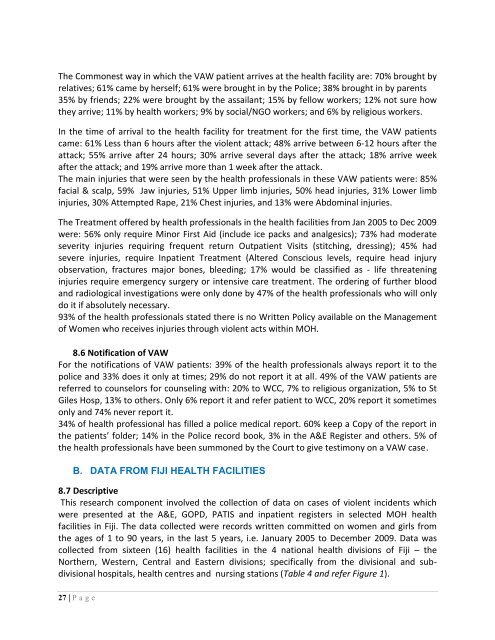Project Report â Fiji 2010 - Pacific Health Voices
Project Report â Fiji 2010 - Pacific Health Voices
Project Report â Fiji 2010 - Pacific Health Voices
Create successful ePaper yourself
Turn your PDF publications into a flip-book with our unique Google optimized e-Paper software.
The Commonest way in which the VAW patient arrives at the health facility are: 70% brought by<br />
relatives; 61% came by herself; 61% were brought in by the Police; 38% brought in by parents<br />
35% by friends; 22% were brought by the assailant; 15% by fellow workers; 12% not sure how<br />
they arrive; 11% by health workers; 9% by social/NGO workers; and 6% by religious workers.<br />
In the time of arrival to the health facility for treatment for the first time, the VAW patients<br />
came: 61% Less than 6 hours after the violent attack; 48% arrive between 6-12 hours after the<br />
attack; 55% arrive after 24 hours; 30% arrive several days after the attack; 18% arrive week<br />
after the attack; and 19% arrive more than 1 week after the attack.<br />
The main injuries that were seen by the health professionals in these VAW patients were: 85%<br />
facial & scalp, 59% Jaw injuries, 51% Upper limb injuries, 50% head injuries, 31% Lower limb<br />
injuries, 30% Attempted Rape, 21% Chest injuries, and 13% were Abdominal injuries.<br />
The Treatment offered by health professionals in the health facilities from Jan 2005 to Dec 2009<br />
were: 56% only require Minor First Aid (include ice packs and analgesics); 73% had moderate<br />
severity injuries requiring frequent return Outpatient Visits (stitching, dressing); 45% had<br />
severe injuries, require Inpatient Treatment (Altered Conscious levels, require head injury<br />
observation, fractures major bones, bleeding; 17% would be classified as - life threatening<br />
injuries require emergency surgery or intensive care treatment. The ordering of further blood<br />
and radiological investigations were only done by 47% of the health professionals who will only<br />
do it if absolutely necessary.<br />
93% of the health professionals stated there is no Written Policy available on the Management<br />
of Women who receives injuries through violent acts within MOH.<br />
8.6 Notification of VAW<br />
For the notifications of VAW patients: 39% of the health professionals always report it to the<br />
police and 33% does it only at times; 29% do not report it at all. 49% of the VAW patients are<br />
referred to counselors for counseling with: 20% to WCC, 7% to religious organization, 5% to St<br />
Giles Hosp, 13% to others. Only 6% report it and refer patient to WCC, 20% report it sometimes<br />
only and 74% never report it.<br />
34% of health professional has filled a police medical report. 60% keep a Copy of the report in<br />
the patients’ folder; 14% in the Police record book, 3% in the A&E Register and others. 5% of<br />
the health professionals have been summoned by the Court to give testimony on a VAW case.<br />
B. DATA FROM FIJI HEALTH FACILITIES<br />
8.7 Descriptive<br />
This research component involved the collection of data on cases of violent incidents which<br />
were presented at the A&E, GOPD, PATIS and inpatient registers in selected MOH health<br />
facilities in <strong>Fiji</strong>. The data collected were records written committed on women and girls from<br />
the ages of 1 to 90 years, in the last 5 years, i.e. January 2005 to December 2009. Data was<br />
collected from sixteen (16) health facilities in the 4 national health divisions of <strong>Fiji</strong> – the<br />
Northern, Western, Central and Eastern divisions; specifically from the divisional and subdivisional<br />
hospitals, health centres and nursing stations (Table 4 and refer Figure 1).<br />
27 | P a g e
















